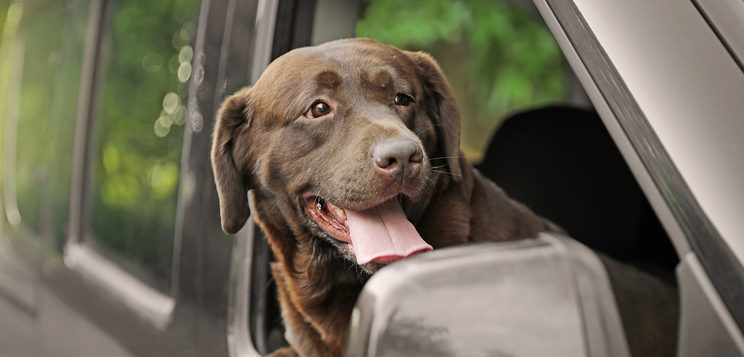The human-animal bond is stronger than ever. In fact, research has found that spending time with our dogs makes us healthier.1-4 But more importantly, we enjoy being with our dogs. We like to take our dogs with us whenever possible: to the park, visiting friends and family, or on a family camping trip. The number of hotels, motels, and bed and breakfast inns that advertise “pet friendly” is a testament to how popular traveling with pets has become. However, if your dog suffers from motion sickness, traveling with her/him can be difficult, if not impossible. Leaving your dog behind may be your only option, but that comes with sadness and an interruption of the human-animal bond. Additionally, motion sickness makes taking your dog on necessary trips, such as veterinary visits, grooming appointments, and doggie day care, challenging.
How do I know if my dog suffers from Motion Sickness?
Motion sickness may be caused by an overstimulation of the areas in the brain associated with balance and motion. Stimulation of these areas of the brain then send signals to another area of the brain associated with vomiting. Motion sickness may be also caused by anxiety caused by riding in a car. 5
Most people know that vomiting is a sign of motion sickness, but other signs include increased drooling, nausea, dry heaving, excessive lip licking and/or panting, inactivity, pacing, restlessness, shaking, whining, or even yawning. Vomiting can be a painful, exhausting, anxiety-inducing experience and the other signs indicate that your dog is uncomfortable and quite possibly miserable.6 Dogs experiencing motion sickness can develop fear, anxiety, and stress associated with riding in the car and become reluctant to get in the car. To see if your dog may suffer from motion sickness, take this quiz, then speak with your veterinarian. Only your veterinarian can determine if your dog’s signs are due to motion sickness.
What are the treatment options for my dog if they are diagnosed with Motion Sickness?
The first and only FDA-approved treatment for vomiting caused by canine motion sickness is a medication called Cerenia® (maropitant citrate). It works by preventing release of a chemical in the brain that causes vomiting. Cerenia tablets are for dogs 4 months of age or older, and are given two hours before traveling, with a small amount of food. Cerenia tablets can be given once a day for up to two days. Cerenia prevents vomiting without causing drowsiness.
Other medications that might be considered for treatment of canine motion sickness include Benadryl® (diphenhydramine) or Dramamine® (dimenhydrinate). Neither of these drugs are approved for use in the dogs, nor have they been shown to be effective or safe for treating canine motion sickness. These medications can cause your dog to become drowsy and it is recommended that you do not use these drugs for the treatment of canine motion sickness. It is however recommended that you speak to your veterinarian about your dog’s motion sickness so that the proper treatment can be started. Once you begin treating your dog’s motion sickness, you can begin to enjoy traveling with your dog.
What other things should I consider before traveling with my dog?
Before you begin traveling with your dog, make an appointment with your veterinarian to make sure that your dog is protected from any parasites or diseases that are common in the area that you are visiting, ensure that your dog has all her/his medications, including those for motion sickness or travel anxiety. If your dog is not microchipped for identification, this would be a good time to get that done as well.
Additionally, you will want to confirm that your dog is welcomed wherever you are traveling and will have a safe place to stay should you need to leave them for a short period of time during your trip. Finally, out of an abundance of caution, have addresses and contact information of veterinary clinics along the way.
When getting ready for a trip, pack a bag for your dog that includes all or some of the following, depending upon the length of your trip:
- Treats, food, water and dishes
- Leashes, collars/halters with ID tags and license
- Carrier and/or doggie seat belt
- Doggie waste bags
- Dog first aid kit
- Toys and bedding
- Medications and medical records, including types and dates of vaccines, rabies certificate, health record, a recent photo of your pet, and your veterinarian’s contact information
Once you are on your way, make frequent stops for your dog to relieve him/herself, get exercise and drink water. Do not leave your dog in the car unattended, especially in the weather if warm/hot or cold.
During your trips together you and your dog will make lasting memories and build an even stronger bond. While on your trip be sure to take lots of photos to document your big adventures and post them to share with other families that are traveling with their dogs.
Additional Safety information for Cerenia:
Safe use of Cerenia has not been evaluated in dogs with gastrointestinal obstruction, or those that have ingested toxins and should be used with caution in dogs with hepatic dysfunction. In people, topical exposure may elicit localized allergic skin reactions, and repeated or prolonged exposure may lead to skin sensitization. See full prescribing information
References
-
- Yates, BJ, et al., Brain Res Bull, 1998. (v1.0)
- Conder, GA., J Vet Pharmacol Ther, 2008. (v1.0)
- Krittanawong, C, et al., Am J Cardiol, 2020 (v1.0)
- Cline, KMC., J Soc Psychol, 2010 (v1.0)
- Krause-Parello, C., J Community Health Nurs, 2008 (v1.0)
- Mickova, E, et al., Int J Environ Res Public Health, 2019 (v1.0)
This article was reviewed/edited by board-certified veterinary behaviorist Dr. Kenneth Martin and/or veterinary technician specialist in behavior Debbie Martin, LVT.
![]() This article is brought to you in collaboration with our friends at Zoetis Petcare. CER-00474
This article is brought to you in collaboration with our friends at Zoetis Petcare. CER-00474








